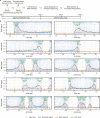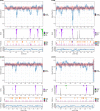Genome-wide mapping of individual replication fork velocities using nanopore sequencing
- PMID: 35676270
- PMCID: PMC9177527
- DOI: 10.1038/s41467-022-31012-0
Genome-wide mapping of individual replication fork velocities using nanopore sequencing
Abstract
Little is known about replication fork velocity variations along eukaryotic genomes, since reference techniques to determine fork speed either provide no sequence information or suffer from low throughput. Here we present NanoForkSpeed, a nanopore sequencing-based method to map and extract the velocity of individual forks detected as tracks of the thymidine analogue bromodeoxyuridine incorporated during a brief pulse-labelling of asynchronously growing cells. NanoForkSpeed retrieves previous Saccharomyces cerevisiae mean fork speed estimates (≈2 kb/min) in the BT1 strain exhibiting highly efficient bromodeoxyuridine incorporation and wild-type growth, and precisely quantifies speed changes in cells with altered replisome progression or exposed to hydroxyurea. The positioning of >125,000 fork velocities provides a genome-wide map of fork progression based on individual fork rates, showing a uniform fork speed across yeast chromosomes except for a marked slowdown at known pausing sites.
© 2022. The Author(s).
Conflict of interest statement
The authors declare no competing interests.
Figures






References
-
- Kapp, L. N. & Painter, R. B. in International Review of Cytology (eds Bourne, G. H., Danielli, J. F. & Jeon, K. W.) (Academic Press, 1982).
-
- Liapunova, N. A. in International Review of Cytology (eds Jeon, K. W. & Jarvik, J.) (Academic Press, 1994).
Publication types
MeSH terms
Substances
LinkOut - more resources
Full Text Sources
Molecular Biology Databases

